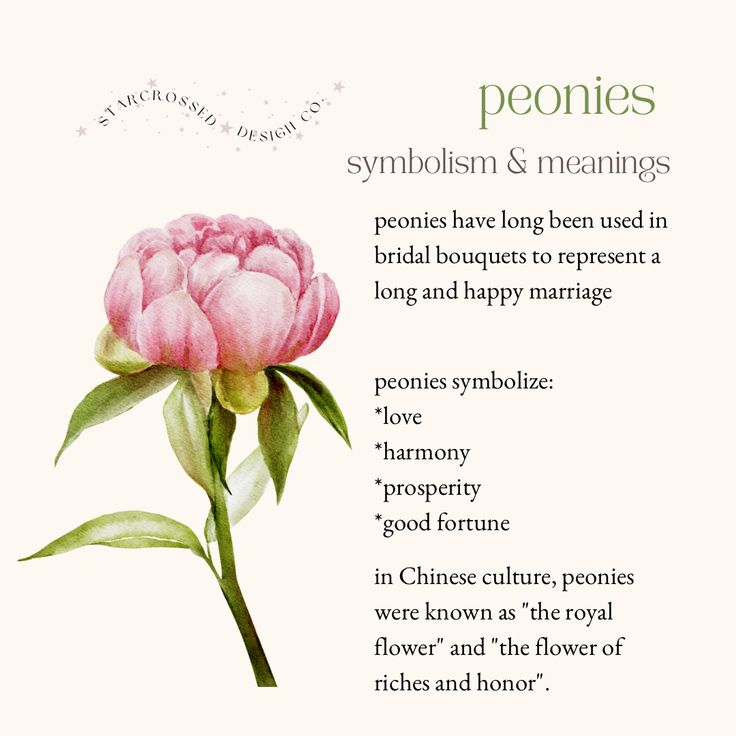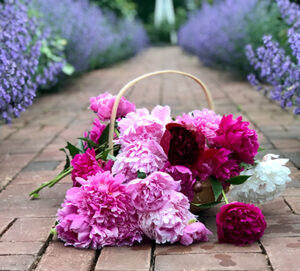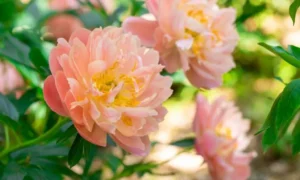Let’s pause for a moment and imagine a field of blooming peonies, with their delicate petals and vibrant colors. These flowers have captured the hearts and minds of humans for centuries, with their rich symbolism and cultural significance. But have you ever wondered what message each petal holds, and how you can use the language of peonies to convey your emotions? In today’s world, where communication can often be misunderstood or lost in translation, understanding the language of flowers is more important than ever. So, let’s dive into the intricate world of peonies and unravel the hidden meanings behind each petal.
What Are Peonies?
Peonies are a type of beautiful flowering plant that can be found in Asia, Europe, and North America. These plants are well-known for their large and fragrant blooms, as well as their lush foliage. They come in a variety of colors, such as white, pink, red, and yellow, and are considered perennial plants, meaning they will return year after year.
Peonies have a long history of being cherished for their beauty and are often used in floral arrangements and gardens. They hold great significance and are seen as symbols of love, romance, and prosperity. Overall, peonies are adored by both gardeners and flower enthusiasts for their breathtaking appearance and symbolic meaning.
The History and Cultural Significance of Peonies
Peonies have long been admired and revered for their beauty and fragrance, but there is much more to these flowers than meets the eye. In this section, we will delve into the rich history and cultural significance of peonies. From their origins in ancient Greek mythology to their symbolism in Chinese culture and their popularity in Western societies, each sub-section will reveal the unique role that peonies have played throughout the ages. Join us as we uncover the fascinating stories and meanings behind this beloved flower.
1. Peonies in Ancient Greek Mythology
According to the ancient Greek mythology, peonies have a fascinating origin story. They were named after Paeon, a student of Asclepius, the Greek god of medicine. Paeon used a peony root to heal Pluto, the god of the underworld, after he was wounded in battle. Impressed by the healing powers of the peony, Asclepius transformed Paeon into a beautiful flower to protect him from jealousy. In ancient Greek culture, peonies were believed to symbolize healing and protection.
Today, peonies are still highly valued for their beauty and are often incorporated into weddings and celebrations. Pro-tip: When selecting peonies for your garden, consider varieties such as Festiva Maxima or Sarah Bernhardt, known for their breathtaking blooms.
2. Peonies in Chinese Culture
Peonies have been deeply ingrained in Chinese culture for thousands of years, holding immense cultural significance. Known as the “King of Flowers,” they represent wealth, honor, and prosperity. In Chinese art and literature, peonies symbolize beauty, femininity, and love. These flowers are also a staple in traditional Chinese weddings, often used in bouquets and decorations to symbolize a happy and prosperous marriage.
The history of peonies in Chinese culture dates back thousands of years, and their cultivation and appreciation remain an important part of Chinese traditions to this day.
3. Peonies in Western Culture
Peonies have a rich history and cultural significance in Western culture. They are often associated with romance, prosperity, and honor. In Western art and literature, peonies are frequently portrayed as symbols of beauty and abundance. They have been featured in famous paintings, poetry, and literature, adding a touch of elegance to these artistic works. Peonies are also popular in weddings, where they are used in bouquets and floral arrangements, symbolizing a happy and prosperous marriage. In Western culture, peonies have become beloved flowers that bring joy and beauty to various celebrations.
Pro-tip: When giving peonies as a gift in Western culture, opt for pink or red varieties for a romantic gesture.
The Symbolism Behind Each Peony Petal
In the world of flowers, peonies hold a special place as one of the most beloved and symbolic blooms. But did you know that each petal of a peony has its own unique meaning and significance? In this section, we will dive into the symbolism behind each peony petal, exploring the meanings behind their colors, numbers, and shapes. By understanding the language of peonies, we can gain a deeper understanding and appreciation for these stunning flowers.
1. The Meaning of the Color of Peony Petals
The color of peony petals carries symbolic meanings that can enhance the overall message or sentiment conveyed by the flower.
- White petals symbolize purity, innocence, and new beginnings.
- Pink petals represent love, romance, and femininity.
- Red petals symbolize passion, desire, and strength.
- Yellow petals signify friendship, joy, and positive energy.
- Purple petals symbolize royalty, elegance, and luxury.
- Orange petals represent enthusiasm, creativity, and optimism.
- Multi-colored petals symbolize diversity, complexity, and uniqueness.
2. The Significance of the Number of Peony Petals
The number of petals on a peony flower holds great significance in various cultural contexts. In Chinese culture, the number 2 is considered lucky as it symbolizes harmony and unity. Peonies with two petals are highly valued for their uniqueness. In Western culture, the number of peony petals is often associated with beauty and perfection, with flowers having an even number of petals seen as more desirable. Additionally, the number of peony petals can hold personal symbolism, such as a peony with five petals representing the five wishes of happiness, wealth, health, love, and a peaceful life. When selecting peonies for bouquets or decorations, considering the symbolism of the number of petals can add a special touch to the occasion. One may also choose to incorporate peonies with different petal numbers to represent specific meanings or aspirations.
3. The Symbolism of Peony Petal Shapes
Peony petal shapes hold significant symbolic meanings in various cultures and artistic expressions.
- Single petals symbolize simplicity, purity, and openness.
- Doubles represent abundance, wealth, and prosperity.
- Semi-doubles embody grace, beauty, and femininity.
- Bomb-shaped petals convey luxury, opulence, and extravagance.
- Ruffled petals suggest playfulness and cheerfulness.
Understanding these symbolic meanings allows for a deeper appreciation of peonies in art, literature, and cultural traditions. Whether depicted in paintings, depicted in poetry, or used in wedding bouquets, peonies with different petal shapes evoke various emotions and convey diverse messages.
Peonies in Art and Literature
Peonies have long been admired for their beauty and fragrance, but they also hold a rich history of symbolism in various forms of art and literature. In this section, we will explore the different ways that peonies have been depicted in paintings, poetry, and literature. From delicate brushstrokes to powerful words, we will unravel the deeper meanings and representations of peonies in these artistic mediums. Get ready to immerse yourself in the language of peonies and discover the hidden messages behind each petal.
1. Peonies in Paintings
Peonies have been a popular subject in paintings throughout history. Here are some steps to appreciate the significance of peonies in paintings:
- Observe the skillful depiction of peony blooms in various stages of growth and decay.
- Notice the attention to detail in capturing the intricate layers of petals and the vibrant colors.
- Appreciate the symbolism associated with peonies, such as prosperity, beauty, and femininity.
Pro-tip: Look for renowned artists like Zhao Mengfu and Vincent van Gogh who have created stunning peony paintings to enhance your understanding and enjoyment of this timeless subject.
2. Peonies in Poetry
Peonies have long been a prominent feature in poetry, symbolizing a variety of emotions and themes. In Chinese poetry, these flowers are often used to represent beauty, grace, and prosperity. Poets use their vibrant colors and delicate petals to evoke feelings of love and yearning. In Western poetry, peonies are often linked to romance and femininity, serving as metaphors for the loveliness and allure of women. Their lush blooms and captivating fragrance inspire poets to capture their essence in verses that celebrate the magnificence of nature. From ancient times to present day, peonies continue to inspire poets with their timeless beauty and symbolic significance.
3. Peonies in Literature
Peonies have played a significant role in literature throughout history. Here are some steps to explore their significance in literary works:
- Research: Discover books, poems, and plays that feature peonies as a theme or symbol.
- Symbolism: Analyze the symbolic meanings attached to peonies in literature, such as beauty, romance, and prosperity.
- Imagery: Examine the descriptive language used to depict peonies in literary works, such as their vibrant colors and delicate petals.
- Motifs: Identify recurring references to peonies in various literary genres, highlighting their role in enhancing themes and plot development.
- Interpretation: Interpret the authors’ intentions behind incorporating peonies into their works, considering cultural, historical, and personal contexts.
- Comparison: Compare how peonies are portrayed in different literary works and analyze any variations in symbolism or interpretation.
The Role of Peonies in Weddings and Celebrations
Peonies have long been a beloved flower in many cultures, and are especially prominent in weddings and celebrations. In this section, we will explore the role of peonies in these joyous occasions and the symbolism behind their presence. From their place in wedding bouquets to their significance in traditional Chinese weddings, peonies hold a special meaning that goes beyond their beauty. We will also touch upon their presence in other celebrations and festivals, shedding light on the wide-reaching impact of this elegant flower.
1. Peonies in Wedding Bouquets
Peonies are a popular choice for wedding bouquets due to their beauty and symbolism. Here are steps to incorporate these elegant flowers into your special day:
- Choose the right variety: Select peony varieties known for their large, full blooms, such as Sarah Bernhardt or Festiva Maxima.
- Select a color scheme: Consider the color palette of your wedding and choose peonies in shades that complement your overall theme.
- Combine with other flowers: Pair peonies with complementary blooms like roses, hydrangeas, or eucalyptus to add texture and dimension to your bouquet.
- Consider the season: Peonies are typically available from late spring to early summer. If your wedding is outside of this season, consult with your florist for alternatives or consider using artificial peonies.
- Bouquet style: Decide on the bouquet style that best suits your wedding. Peonies work well in various styles, such as cascading, hand-tied, or posy bouquets.
By following these steps, you can create a stunning wedding bouquet that showcases the beauty and symbolism of peonies.
2. Peonies in Traditional Chinese Weddings
In traditional Chinese weddings, peonies hold great significance and are incorporated in various ways. Here are the steps involved in the use of peonies in traditional Chinese weddings:
- Peony Decorations: Peonies are used to decorate the wedding venue, symbolizing prosperity, honor, and a happy marriage.
- Bridal Bouquet: The bride carries a bouquet of peonies, representing a blissful and prosperous marriage.
- Wedding Attire: Peonies are embroidered or printed on the wedding dress, symbolizing beauty, love, and romance.
- Tea Ceremony: Peonies are often used as decoration during the traditional tea ceremony, signifying a harmonious union and fertility.
- Wedding Cake: Peonies are used as cake decorations, adding elegance and auspiciousness to the celebration.
- Wedding Invitations: Peony motifs are commonly used in wedding invitations to symbolize a joyous and successful union.
These steps illustrate the important role that peonies play in traditional Chinese weddings, adding beauty and cultural significance to the celebration.
3. Peonies in Other Celebrations and Festivals
Peonies are not only popular in weddings but also play a significant role in other celebrations and festivals. Here are some steps to understand their involvement:
- Identify the festivals and celebrations where peonies are commonly used, such as spring festivals or garden tours.
- Learn about the cultural symbolism associated with peonies, such as prosperity, honor, or beauty in different cultures.
- Use peonies to decorate event spaces, create floral arrangements, or make garlands.
- Understand the color symbolism of peonies, as different colors can convey various emotions or messages.
- Explore how peonies are used in specific celebrations, like the Peony Festival in Luoyang, China.
- Immerse yourself in the festivities by attending parades, competitions, or exhibitions centered around peonies.
Frequently Asked Questions
What is the language of peonies?
The language of peonies refers to the symbolism behind each petal, as different colors and shapes can hold different meanings.
What are some common symbols associated with peonies?
Some common symbols associated with peonies include prosperity, love, honor, and beauty.
What does the color of a peony represent?
The color of a peony can represent different emotions and meanings, with pink representing romance, red representing passion, and white representing purity.
What is the significance of the number of peony petals?
The number of peony petals can also hold symbolic meaning, with an even number representing happiness and an odd number representing grace and mystical powers.
Are there any negative connotations associated with peonies?
In some cultures, peonies can also symbolize shame or anger, so it is important to understand the context and cultural significance when interpreting their symbolism.
How can I use the language of peonies in my own life?
You can incorporate the symbolism of peonies into your life by gifting them to represent different emotions, or by using their imagery in art or home decor. Understanding the language of peonies can also help in interpreting their symbolism in literature and other forms of art.



